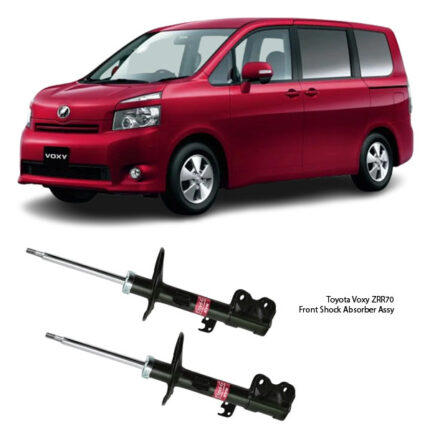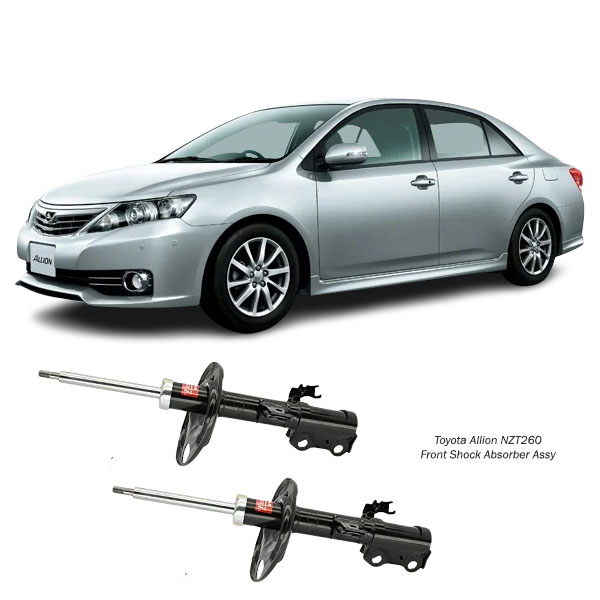Get Toyota Allion NZT260 Front Shock Absorber Assy 338031 in Kenya
The front shock absorber assembly is a key component of the suspension system located at the front of a vehicle. Its primary function is to control and dampen the movement of the suspension and the wheels. As a vehicle moves over uneven surfaces or experiences changes in speed or direction, the front shock absorbers regulate the impact and energy produced by such motion, ensuring stability, comfort, and safety.
Unlike springs, which absorb the energy from road impacts, shock absorbers dissipate this energy by converting it into heat. They do not carry the vehicle’s weight, but they are essential in controlling the up-and-down motion of the suspension, preventing excessive bouncing and maintaining tire contact with the road.
Construction and Components
A standard front shock absorber assembly consists of several key parts:
-
Piston and Piston Rod
The piston moves up and down inside a hydraulic cylinder filled with oil. The piston rod connects the piston to the suspension mount on the vehicle. -
Hydraulic Fluid
The shock absorber is filled with special oil that helps dissipate energy as the piston forces the fluid through small orifices and valves, creating resistance. -
Cylinder (Outer and Inner Tubes)
The inner tube houses the hydraulic fluid and piston. The outer tube, or reservoir, stores excess fluid and allows for expansion under heat. -
Mounts and Bushings
Rubber or polyurethane bushings at both ends of the assembly reduce vibration and noise while allowing controlled movement. -
Dust Boot
A protective cover that shields the piston rod from dirt, debris, and moisture, extending the shock’s lifespan. -
Bump Stop
A cushioning component that prevents metal-to-metal contact when the shock absorber is fully compressed.
In some designs, the front shock absorber assembly may include a coil spring, forming a strut assembly that provides structural support as well as dampening.
How It Works
As the vehicle moves, the suspension compresses and rebounds. This movement pushes the piston inside the shock absorber through the hydraulic fluid. The internal resistance created by the fluid flowing through valves and orifices slows the motion of the piston. This resistance transforms kinetic energy into heat, effectively controlling the movement of the suspension.
The goal is to keep the front wheels in constant contact with the road for optimal grip, braking, and steering. By limiting excessive motion, the front shock absorbers contribute to both comfort and safety.
Advantages of a Good Front Shock Absorber Assembly
-
Ride Comfort
Quality front shock absorbers reduce the effects of bumps, potholes, and road imperfections, making the ride smoother for the driver and front-seat passengers. -
Improved Steering Response
The front suspension system is directly tied to the steering mechanism. Well-functioning front shocks ensure consistent handling, especially during turns or lane changes. -
Braking Stability
Good front shocks minimize nose-diving during braking, maintaining better weight distribution and reducing stopping distances. -
Enhanced Tire Contact
By keeping the front tires firmly planted on the road surface, front shock absorbers ensure maximum traction during acceleration, braking, and turning. -
Reduced Wear on Other Components
Proper damping protects other suspension and steering components such as control arms, tie rods, and wheel bearings from excessive stress and premature wear. -
Noise and Vibration Reduction
A properly functioning shock absorbs not only motion but also road noise and vibrations, contributing to a quieter, more pleasant driving experience.
Disadvantages and Effects of a Worn or Faulty Front Shock Absorber
-
Poor Ride Quality
If the front shocks are worn, the vehicle will bounce excessively over bumps, causing discomfort and instability. -
Decreased Handling and Control
Worn front shocks can lead to delayed steering response, body roll, and difficulty maintaining control, especially in emergencies or during sharp turns. -
Longer Braking Distances
A faulty front shock absorber causes the vehicle to nosedive during braking, reducing braking efficiency and increasing stopping distance. -
Tire Damage
Bad shocks allow the tires to bounce off the road, leading to uneven wear patterns such as cupping or scalloping. -
Suspension System Strain
Without proper damping, other suspension components absorb excessive impact forces, increasing the risk of damage and costly repairs. -
Increased Road Noise and Vibration
A damaged shock may fail to dampen road vibrations, leading to rattling noises and a harsh ride.
Signs of a Worn-Out Front Shock Absorber
-
Excessive Bouncing After Bumps
If the vehicle continues to bounce after passing over a bump, the front shocks may be weak or failing. -
Nose-Diving When Braking
A clear sign of worn shocks is the front end dipping sharply during sudden stops. -
Steering Instability
Poor control or delayed response while steering may be linked to worn front shock absorbers. -
Uneven Tire Wear
Irregular tread patterns or tire cupping on the front tires indicate inconsistent contact with the road surface, often caused by weak shocks. -
Visible Fluid Leaks
Oil seeping from the shock body indicates a damaged seal and compromised performance. -
Clunking or Rattling Noises
Noises from the front suspension when driving over rough surfaces can signal internal damage or loosened shock mounts. -
Increased Stopping Distance
Longer-than-usual braking distances may be due to poor front suspension control.
How to Replace a Front Shock Absorber Assembly
Tools and Materials Needed:
-
Jack and jack stands or lift
-
Socket and wrench set
-
Torque wrench
-
Penetrating oil
-
New front shock absorber assembly
-
Spring compressor (if part of a strut assembly)
Step-by-Step Replacement Guide:
-
Safety First
Park the vehicle on a flat surface, engage the parking brake, and secure the rear wheels with chocks. -
Raise the Vehicle
Use a jack to lift the front end and place jack stands under the frame for support. -
Remove the Front Wheels
Take off the front wheels to access the shock absorber assembly. -
Locate the Shock Mounting Points
Identify the upper and lower mounting bolts. These are typically attached to the frame and the control arm or steering knuckle. -
Apply Penetrating Oil
If bolts are corroded, spray them with penetrating oil and allow time to soak. -
Unbolt the Old Shock Absorber
Support the lower control arm and remove the mounting bolts. Carefully remove the old shock from the vehicle. -
Install the New Shock Absorber
Align the new shock absorber in position and secure it using the original or replacement bolts. Use a torque wrench to tighten bolts to manufacturer specifications. -
Reinstall the Wheel and Lower the Vehicle
Put the wheel back on, tighten the lug nuts, and lower the vehicle safely. -
Test the Installation
Take a short drive to test ride quality, steering feel, and braking stability.
Follow us on Facebook for more parts.




